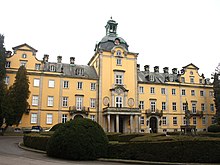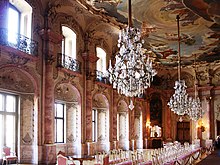Buckeburg Castle
Bückeburg Castle is a castle in Bückeburg and ancestral seat of the House of Schaumburg-Lippe , the ruling dynasty of the state of Schaumburg-Lippe until 1918 .
history
Middle Ages and Modern Times


The founding of the Bückeburg as a forerunner of the castle can be traced back to the year 1304, when it was first mentioned in a document. At the beginning of the 14th century, Count Adolf VI. from Schauenburg and Holstein-Pinneberg the moated castle Bückeburg, in order to monitor the important trade route Hellweg from here . It was named after the old Bückeburg , which fell into disrepair around 1181, in nearby Obernkirchen , the castle of the Counts of Bukkigau . Initially, the fortifications consisted of a fortified tower and farm buildings, in front of which a small settlement developed over time.
In 1365 the small town of bukkiborg received the local justice , and around 1396 Otto I von Schaumburg appointed a clergyman to his newly built chapel. In 1492 the castle had only 13 rooms, but by 1527 under John IV it developed into a fortified complex with moats, ramparts and bastions .
From 1560, Otto IV von Schaumburg had the original moated castle redesigned into a representative four-wing palace in the Weser Renaissance style in just four years . For this purpose, some of the existing structure was integrated into the new building. Heinrich Schrader and Jacob Kölling were responsible as builders. The west and north wings were connected by the so-called Trumpeter Walk , an open gallery on the courtyard side .
Renaissance
Otto's son Ernst von Holstein-Schaumburg , who ruled from 1601 to 1622 and was prince in 1619, made Bückeburg his residence in 1607. He granted her city rights , had new roads laid out, fortifications and buildings built; including the town church with the early baroque facade from 1615. On the market square, he had the outer castle portal with a flanking administration building, the Princely Court Chamber , which still exists today , and the ballroom built. Ernst transformed the garden laid out under his father into a typical, quite representative Renaissance garden . In 1622 the great stables were the last to be built. The palace chapel received an early baroque wooden decoration and was completely painted in the Mannerist style. The filigree wooden decoration of the palace chapel was made by the two Hildesheim sculptors Ebbert the Younger and Jonas Wulff .
For the outer terrace of the palace, Prince Ernst commissioned two sculptures from the famous sculptor Adriaen de Vries in Prague between 1620 and 1621 , Venus and Adonis and The Robbery of the Sabine Woman . The originals are now in the Bode Museum in Berlin, casts are placed on the Bückeburg Palace Bridge. Already in 1615 Ernst had commissioned the large bronze baptismal font for the Bückeburg city church from de Vries and the resurrection monument for the Princely Mausoleum in Stadthagen from 1617–1621 . Both are still in place.
One day after Ernst's death, foreign mercenaries were standing in the city and the calamity of the Thirty Years War raged, which is why construction work did not start again until 1695. After the Counts of Holstein-Schaumburg had died out in the male line with Otto V in 1640 , the castle and parts of the Grafschaft Schaumburg came to Count Philipp , who founded the Schaumburg-Lippe line. He had the walls of the castle chapel whitewashed completely white because of his reformed faith, which is why the art-historically highly significant fresco paintings disappeared under the paint for centuries.
Baroque

From 1728 to 1748 Albrecht Wolfgang zu Schaumburg-Lippe ruled in Schaumburg. During this time Voltaire made several visits to Bückeburg, who received the first inspiration for his famous novel Candide (the castle of Baron Thunder-ten-tronckh in Westphalia ). In 1732 the north and south wings of the main building burned down in a few hours, but were rebuilt within a year with a fire tax levied. At the same time, the inner moat was filled with the rubble, thus increasing the limited space inside the wall.
Albrecht-Wolfgang had in mind a more generous structure with an additional wing extension, but the income from the tax only allowed the reconstruction of the destroyed east and south wings. The new style, now baroque, still shapes the appearance of the palace today. The count also had a baroque garden laid out in place of the renaissance garden, but the splendor of the garden only remained until 1748.
Wilhelm zu Schaumburg-Lippe ruled from 1748 to 1777 , who, as a military strategist, also had his father's palace garden provided with ramparts and ditches after the garden sculptures had previously been moved to the garden of Baum Palace . Under his successor, Philipp Ernst (1777–1787), the palace garden was turned back into a park with an attached large fruit tree nursery. His wife Juliane had part of the garden converted into an English landscape garden . From 1820, large ponds were created in the so-called courtyard meadows in the south of the castle, in which carp were kept until the 1990s . These ponds are now a valuable biotope for amphibians and water birds.
historicism
It was not until 1860 that the palace rooms were renovated under Prince Adolf Georg ; including the Golden Hall - formerly the White Room - which was decorated between 1863 and 1867 with, among other things, the red silk wallpaper that has been preserved to this day. The castle chapel was also thoroughly restored from 1879 to 1885. When installing the large organ, the pulpit wall, which until then had been attached directly to the rear wall, had to be moved almost three meters into the room. The frescoes, which were whitewashed in 1648, were completely exposed again and today one gets a deep insight into the formal language of Mannerism.
Major changes took place between 1893 and 1896, when the tower received a new wing extension. This extension corresponds to the plans that Albrecht Wolfgang had as early as 1732, namely to move the tower into the middle of the castle by means of an extension. The main part of the extension is taken up by the large ballroom (9 meters high, 12 meters wide and almost 24 meters long.) In the basement, a modern large kitchen was installed with the latest technology, which could cater for 250 people. At the same time, the chancellery and the old kitchen that had been built under Otto IV were demolished. The castle forecourt was given an almost closed development with two semicircular cavalier houses with an associated formal garden.
From 1911 to 1915, Prince Adolf had a mausoleum built on the edge of the palace park as a burial place for the Princely House. The architect was the Berlin professor Paul Otto August Baumgarten . The largest gold mosaic dome in Europe is 25 meters high and has an area of 500 m². This huge building with its own park is still the burial place of the princely family.
Todays use

Bückeburg Castle has been inhabited continuously since it was built; originally by the Counts of Holstein-Schaumburg and from 1640 by the members of the Count's, later the Princely Family of Schaumburg-Lippe. Today Alexander Prince zu Schaumburg-Lippe lives in the castle.
Individual rooms have been open to the public since 1925, including the palace chapel, the golden hall and the large ballroom. Since May 2004, the Bückeburg Riding School has been located in the Marstall , where the riding art of the European eras from the 11th to 17th centuries is shown and cultivated. Schloss Bückeburg is also the venue for a wide variety of festivals and exhibitions, for example the “ Country Party ” that takes place every year in early summer , the “Christmas Magic ”, which takes place on the first two Advent weekends of each year within the castle and in the surrounding area and which, according to the company, has around 70,000 People visit every year, as well as the medieval market " Medieval Fantasy Spectaculum " in July. Vintage car rallies , in which the castle is included as a station, also met with great interest from the public . For some time now, civil weddings have been possible in the baroque music hall, and the palace chapel can now also be used by wedding couples of different Christian denominations. The ballroom and other rooms can be rented for private events.
On January 21, 2011, the completed 1:60 precision model of the castle was installed in the marble hall. A café-restaurant is located in the rooms of the historical kitchen. There the guest can use old menus, photos and original room furnishings to get an authentic insight into the former grand kitchen.
The Lower Saxony State Archive of Bückeburg is located in the east wing of the palace complex .
The castle park, which is freely accessible (except during the “Landpartie” in early summer) has a size of over 80 hectares and surrounds the castle on all sides. There are some species of trees that are rare worldwide, such as southern beeches , bald cypresses or an almost 25 meter high sequoia tree behind the mausoleum.
Every autumn , the master classes of the International Music Academy for soloists are held in Bückeburg Castle .
Replica
In the town of Obihiro on the island of Hokkaidō in Japan, there is a faithful replica of the Bückeburg Castle, which was commissioned in 1989 by a Japanese investor. It is part of the amusement park "Glücks-Kingdom" , which has already been closed. The complex is thematically based on the fairy tales of the Brothers Grimm and, in addition to Bückeburg Castle, also includes numerous other German sights , such as a copy of the Bremen Town Musicians or the monument to the Brothers Grimm in Hanau .
For the opening of the replica on July 1, 1989, in addition to Japan's then Prince Tomohito , Philipp Ernst zu Schaumburg-Lippe and Bückeburg's then mayor Helmut Preul and the Schaumburg fairy tale singers came to visit.
literature
- Johannes Habich : The artistic design of the Bückeburg residence by Prince Ernst. 1601-1622. Grimme, Bückeburg 1969 (dissertation University of Hamburg, (= Schaumburger studies; issue 26)).
- Heiner Borggrefe: The Bückeburg Residence - Architectural Design in the Early Modern Princely State . Jonas Verlag, Marburg 1994, ISBN 3-89445-180-7 .
- Palaces and castles . Parragon, Cologne 2006, pp. 78-79, ISBN 1-40547-886-1 .
- Heiner Borggrefe: Bückeburg Castle - courtly splendor, princely representation . Hanover 2008.
- Hans-Wilhelm Heine : Schaumburger Land - Burgenland , in the series Guide to the Prehistory and Early History of Lower Saxony (29), Oldenburg, 2010, published by the Lower Saxony State Office for Monument Preservation and the Archaeological Commission for Lower Saxony , ISBN 978-3-89995-673- 3
Web links
- Site of the castle
- Entry by Stefan Eismann about Schloss Bückeburg in the scientific database " EBIDAT " of the European Castle Institute
- Reconstruction drawing in the medieval state
- Information about Bückeburg Castle with pictures of the castle park
- Princely Riding School Bückeburg
- Bückeburg Castle at Burgenarchiv.de with pictures and information
Individual evidence
- ↑ Boris Kuznetsov (coordinator, organization): International Music Academy for Soloists , Booklet [o. D.], can be downloaded from imas-meisterkurse.de as a PDF document , last accessed on January 12, 2014
- ↑ Has Alexander discovered his weakness for wild growth? In: sn-online.de , accessed on February 24, 2018.
Coordinates: 52 ° 15 '32 " N , 9 ° 2' 37" E





